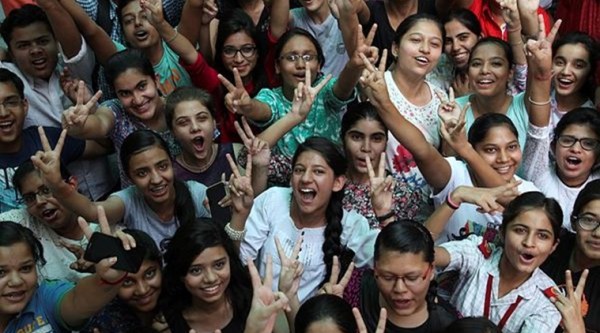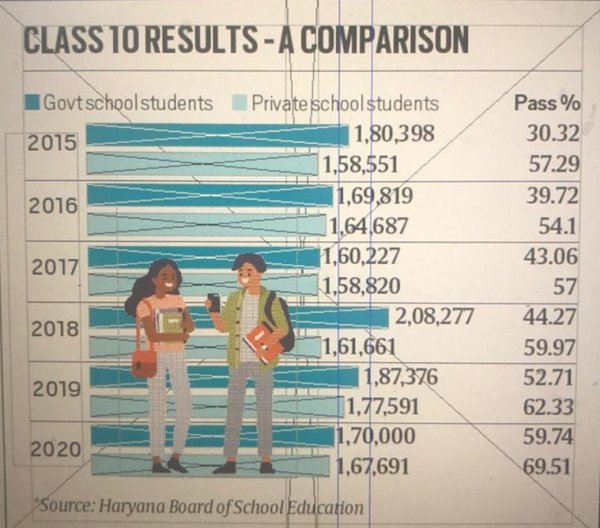 This year, as many as 1.7 lakh students of government schools had appeared for class exams. (Representational)
This year, as many as 1.7 lakh students of government schools had appeared for class exams. (Representational)
In the past five years, the pass percentage of class 10 students of Haryana government schools has improved to almost double — from just 30.32 per cent in 2015 to 59.74 per cent this year. This growth is much higher in comparison to the results of private school students whose pass percentage has gone up to 69.51 per cent this year from 57.29 per cent in 2015, according to official figures based on the results of the Haryana Board of School Education.
According to the state government, the pass percentage of government school students is better than even private school students in many districts this year despite the fact that almost 70 per cent government school students belong to underprivileged sections, including Dalits and below poverty line (BPL) families. “It did not happen overnight, this is the result of consistent efforts that took place during the past five years including introduction of online transfer policy and ensuring presence of teachers in the schools through biometric attendance system,” said Haryana Additional Chief Secretary (School Education) Mahavir Singh.
In Yamunanagar and Panchkula districts, officials said, the pass percentage has increased by 25 per cent and 35 per cent respectively this year in comparison to last year, which is “unprecedented”. More than 12,000 students have found a place in the merit list by securing above 80 per cent, which according to them is a record, if the results of previous years are taken into account. Now, they are eligible for scholarships.
 This growth is much higher in comparison to the results of private school students whose pass percentage has gone up to 69.51 per cent this year from 57.29 per cent in 2015, according to official figures based on the results of the Haryana Board of School Education.
This growth is much higher in comparison to the results of private school students whose pass percentage has gone up to 69.51 per cent this year from 57.29 per cent in 2015, according to official figures based on the results of the Haryana Board of School Education.
The BJP government had faced criticism when the results of class 10 exams were declared in 2015, a few months after the saffron party had taken over. Then state education minister Ram Bilas Sharma had blamed the previous governments for poor results. “This year (2015) Haryana Board of School Education has not followed the trend of giving grace marks to increase the pass percentage which was in practice during the previous regimes. We have declared the actual results so that true picture and fact could be presented,” Sharma had claimed then.
This year, as many as 1.7 lakh students of government schools had appeared for class exams. The number of private school students was little lower. According to officials, students of government schools have performed well even in subjects like of English and math, which usually witness low pass percentage in Haryana.
The results of class 12 are more encouraging this year with 79.78 per cent students of government schools clearing the exam. The pass percentage was 50.57 per cent in 2015. “In past five years, the success rate of government school students has increased by 60 per cent,” said Mahavir Singh. In the improvement of pass percentage in class 12 exams, the students of government schools have given tough competition to private schools in the past five years.
The success rate of private school students has increased to 80.97 per cent this year from 54.52 per cent of 2015. Notably, this year almost five per cent more students of government schools appeared for the senior secondary exam in comparison to private schools. However, five years back, the private schools had an edge of five per cent over government schools in the number of students appearing for this exam.
“It’s usually said there are no studies in government schools. But figures tell a different story. The improvement in results of government schools is faster than of private schools. Now the number of those students who get more than 60 per cent marks has increased while earlier most of the students used to clear exams by getting 30 per cent to 40 per cent marks,” said Mahavir Singh.
Out of 1.09 lakh students of 10+2, according to officials, as many as 37,796 students belong to Scheduled Castes while 39,000 are from Backward Castes and BPL families. Only 32,567 students are from the general category. About 70 per cent students of government schools are from rural areas.
The government says the “transparent online transfer policy” for teachers has helped a lot in developing a positive atmosphere in the schools as now the teachers don’t have to fear repeated and unscheduled transfers. “As part of a strategy, the students were provided question papers of board classes that took place in the past three years. The students were provided answer sheets of toppers so that other students can understand how the questions should be solved. This led to an increase in the number of toppers from government schools.
Additional classes were held to ensure preparations of the exams, weekly and monthly tests were planned and more teachers were provided for the schools,” said Mahavir Singh.
In the beginning of this year too, a one-day workshop was held in Kurukshetra where those school heads were invited whose schools’ pass percentage was less than 20 per cent. Senior officers including Singh interacted with the school heads to get prepared a strategy to improve results of their schools.
‘Liberal marking, more short-answer questions may have played a role’
Wazir Singh, spokesperson of Haryana Vidyalaya Adhyapak Sangh, a body of government school teachers, said, “There is no doubt that the government schools have qualified, experienced and dedicated teachers. (But) Liberal marking and change in the style of question papers which includes prominence of questions of short answer and multiple choice may also have played an important role in the improvement of results. To improve the education system further, the infrastructure of government schools should be strengthened and teachers’ promotions should be ensured on time apart from recruitment of 50,000 teachers against the current vacancies.”
Haryana Private School Association president Kulbhushan Sharma claimed that the present exam system favours the students of government schools. “The exams are conducted by government staffers. Exam centres for students of government schools are mostly set up in the same schools while students of private schools have to move to distant places for the same. The real picture will emerge only if the exam centres for government school students are set up in the private schools and vice-a-versa. Further, the answer sheets should be evaluated by the third party not by government staffers,” he added.